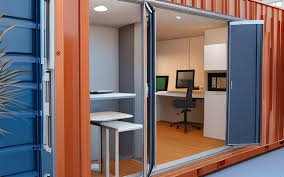Workspaces have changed a lot in recent years. More people are working from home, starting small businesses, or looking for flexible office options. At the same time, there’s a growing focus on sustainable and cost-effective building solutions. These changes have made alternative workspace options, like container offices, more popular than ever.
Among these, insulated container homes stand out as a smart choice. They combine efficiency, comfort, and flexibility in a way that meets today’s needs. Many people are exploring modern property solutions that offer both functionality and style, and insulated container workspaces fit that description perfectly.
What Is an Insulated Container Home?
An insulated container home is made from a shipping container that has been converted into a livable or workable space. The container is fitted with insulation materials to regulate temperature and improve comfort.
Unlike a standard steel container, which can get very hot or cold, an insulated unit keeps the interior temperature more stable. This makes it a suitable choice for year-round use. Insulation can be added using spray foam, rigid boards, or panels, depending on the climate and budget.
Energy Efficiency and Cost Savings
One of the biggest advantages of insulated container workspaces is energy efficiency. Good insulation reduces heat loss in winter and keeps cool air inside during summer. This means lower energy bills for heating and cooling.
For example, a well-insulated container can cut energy use by up to 40% compared to a non-insulated one. Over time, this adds up to significant savings, especially for people running a small business or working from home full-time.
Comfort and Productivity
A comfortable workspace helps you focus and get more done. Insulated container offices maintain a steady indoor temperature, so you’re not distracted by extreme heat or cold.
Sound insulation is another benefit. It reduces noise from outside, making it easier to take calls, join online meetings, or concentrate on detailed tasks. With the right design, you can also include windows, skylights, or vents to bring in natural light and fresh air, which can boost mood and productivity.
Space Flexibility and Customization
Space Flexibility and Customization
One reason people choose container workspaces is their adaptability. You can start with a single container and later expand by adding more units.
Inside, you can design the layout to fit your needs—whether that’s an open-plan office, a meeting area, or a multi-use space with storage. Containers are also portable, which means you can move your workspace if your location or business changes.
Eco-Friendly and Sustainable Choice
Insulated container homes support sustainable living. They repurpose shipping containers that might otherwise go to waste. This reduces the demand for new building materials and helps cut down on construction waste.
Their smaller footprint also means less energy use compared to large traditional buildings. If you want to take things further, you can add solar panels, rainwater collection systems, and other eco-friendly features to your container workspace.
Quick Setup and Minimal Disruption
Setting up a container workspace is much faster than building a traditional office. Prefabricated units can be ready in weeks instead of months.
Since most of the work is done off-site, there’s minimal disruption to your property. Often, you just need a flat surface or simple foundation to get started. This makes it an appealing option for people who want a functional office space without long delays.
Real-Life Examples
Real-Life Examples
Many professionals have successfully set up insulated container offices.
- A freelance designer converted a 20-foot container into a bright, energy-efficient studio with floor-to-ceiling windows.
- A small landscaping company uses a modified container as a mobile office that moves between job sites.
- A remote worker transformed a backyard container into a quiet, comfortable workspace with built-in storage and a mini kitchen.
Things to Consider Before Choosing One
Things to Consider Before Choosing One
Before investing in an insulated container workspace, check your local building codes and permit requirements.
Plan your budget carefully, factoring in delivery, installation, and customization costs. The type of insulation you choose should match your climate—thicker insulation for colder areas, and lighter materials for warmer ones.
It’s also wise to consult with a professional who has experience in container conversions to avoid costly mistakes. You can find more guidance in helpful real estate resources that cover workspace planning and investment tips.
Conclusion
Conclusion
Insulated container homes are an efficient, comfortable, and eco-friendly option for modern workspaces. They help reduce energy costs, improve productivity, and offer flexible layouts that adapt to your needs.
If you’re looking for a cost-effective and sustainable office solution, an insulated container home could be the right fit. Start by exploring design options, checking local regulations, and creating a plan that works for your space and budget.


